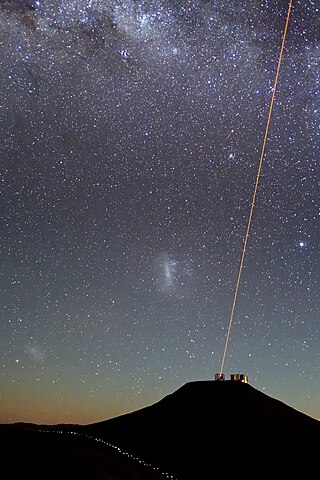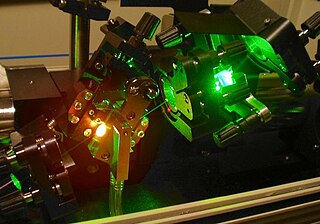Related Research Articles

A laser is a device that emits light through a process of optical amplification based on the stimulated emission of electromagnetic radiation. The word laser is an anacronym that originated as an acronym for light amplification by stimulated emission of radiation. The first laser was built in 1960 by Theodore Maiman at Hughes Research Laboratories, based on theoretical work by Charles H. Townes and Arthur Leonard Schawlow.

A laser is constructed from three principal parts:

The active laser medium is the source of optical gain within a laser. The gain results from the stimulated emission of photons through electronic or molecular transitions to a lower energy state from a higher energy state previously populated by a pump source.

An optical amplifier is a device that amplifies an optical signal directly, without the need to first convert it to an electrical signal. An optical amplifier may be thought of as a laser without an optical cavity, or one in which feedback from the cavity is suppressed. Optical amplifiers are important in optical communication and laser physics. They are used as optical repeaters in the long distance fiber-optic cables which carry much of the world's telecommunication links.
Q-switching, sometimes known as giant pulse formation or Q-spoiling, is a technique by which a laser can be made to produce a pulsed output beam. The technique allows the production of light pulses with extremely high (gigawatt) peak power, much higher than would be produced by the same laser if it were operating in a continuous wave mode. Compared to modelocking, another technique for pulse generation with lasers, Q-switching leads to much lower pulse repetition rates, much higher pulse energies, and much longer pulse durations. The two techniques are sometimes applied together.

A dye laser is a laser that uses an organic dye as the lasing medium, usually as a liquid solution. Compared to gases and most solid state lasing media, a dye can usually be used for a much wider range of wavelengths, often spanning 50 to 100 nanometers or more. The wide bandwidth makes them particularly suitable for tunable lasers and pulsed lasers. The dye rhodamine 6G, for example, can be tuned from 635 nm (orangish-red) to 560 nm (greenish-yellow), and produce pulses as short as 16 femtoseconds. Moreover, the dye can be replaced by another type in order to generate an even broader range of wavelengths with the same laser, from the near-infrared to the near-ultraviolet, although this usually requires replacing other optical components in the laser as well, such as dielectric mirrors or pump lasers.

Ti:sapphire lasers (also known as Ti:Al2O3 lasers, titanium-sapphire lasers, or Ti:sapphs) are tunable lasers which emit red and near-infrared light in the range from 650 to 1100 nanometers. These lasers are mainly used in scientific research because of their tunability and their ability to generate ultrashort pulses. Lasers based on Ti:sapphire were first constructed and invented in June 1982 by Peter Moulton at the MIT Lincoln Laboratory.
Injection seeders are devices that direct the output of small "seed" lasers into the cavity of a much larger laser to stabilize the latter's output. Most seed lasers are stable, single-frequency lasers that emit within the linewidth of the larger laser's gain medium. The single frequency encourages the larger laser to lase in a single longitudinal mode, and the seed laser can also improve the laser's spatial profile and improve the M2 parameter. Seed lasers can be continuous or pulsed. Seeding a pulsed laser can reduce variations in the output energy and timing (jitter) from pulse to pulse, and smooth out temporal variations within the pulse. Many commercial lasers use a laser diode as a seeding source.
A fiber laser is a laser in which the active gain medium is an optical fiber doped with rare-earth elements such as erbium, ytterbium, neodymium, dysprosium, praseodymium, thulium and holmium. They are related to doped fiber amplifiers, which provide light amplification without lasing.

Coherent addition of lasers is a method of power scaling. It allows increasing the output power and brightness of single-transversal mode laser.

A disk laser or active mirror (Fig.1) is a type of diode pumped solid-state laser characterized by a heat sink and laser output that are realized on opposite sides of a thin layer of active gain medium. Despite their name, disk lasers do not have to be circular; other shapes have also been tried. The thickness of the disk is considerably smaller than the laser beam diameter. Initially, this laser cavity configuration had been proposed and realized experimentally for thin slice semiconductor lasers.
The Institute for Laser Science is a department of the University of Electro Communications, located near Tokyo, Japan.
Power scaling of a laser is increasing its output power without changing the geometry, shape, or principle of operation. Power scalability is considered an important advantage in a laser design. This means it can increase power without changing outside features.
Self-pulsation is a transient phenomenon in continuous-wave lasers. Self-pulsation takes place at the beginning of laser action. As the pump is switched on, the gain in the active medium rises and exceeds the steady-state value. The number of photons in the cavity increases, depleting the gain below the steady-state value, and so on. The laser pulsates; the output power at the peaks can be orders of magnitude larger than that between pulses. After several strong peaks, the amplitude of pulsation reduces, and the system behaves as a linear oscillator with damping. Then the pulsation decays; this is the beginning of the continuous-wave operation.
Round-trip gain refers to the laser physics, and laser cavities. It is gain, integrated along a ray, which makes a round-trip in the cavity.

Francisco Javier "Frank" Duarte is a laser physicist and author/editor of several books on tunable lasers.
A random laser (RL) is a laser in which optical feedback is provided by scattering particles. As in conventional lasers, a gain medium is required for optical amplification. However, in contrast to Fabry–Pérot cavities and distributed feedback lasers, neither reflective surfaces nor distributed periodic structures are used in RLs, as light is confined in an active region by diffusive elements that either may or may not be spatially distributed inside the gain medium.
A superluminescent diode is an edge-emitting semiconductor light source based on superluminescence. It combines the high power and brightness of laser diodes with the low coherence of conventional light-emitting diodes. Its emission optical bandwidth, also described as full-width at half maximum, can range from 5 up to 750 nm.
Laser linewidth is the spectral linewidth of a laser beam.
A liquid-crystal laser is a laser that uses a liquid crystal as the resonator cavity, allowing selection of emission wavelength and polarization from the active laser medium. The lasing medium is usually a dye doped into the liquid crystal. Liquid-crystal lasers are comparable in size to diode lasers, but provide the continuous wide spectrum tunability of dye lasers while maintaining a large coherence area. The tuning range is typically several tens of nanometers. Self-organization at micrometer scales reduces manufacturing complexity compared to using layered photonic metamaterials. Operation may be either in continuous wave mode or in pulsed mode.
References
- ↑ D. Kouznetsov; J.F. Bisson; K. Takaichi; K. Ueda (2005). "Single-mode solid-state laser with short wide unstable cavity". JOSA B . 22 (8): 1605–1619. Bibcode:2005JOSAB..22.1605K. doi:10.1364/JOSAB.22.001605.
- ↑ F. J. Duarte (1990). "Narrow-linewidth pulsed dye laser oscillators". In F. J. Duarte; L. W. Hillman (eds.). Dye Laser Principles. Boston: Academic Press. pp. 133–183 and 254–259. ISBN 978-0-12-222700-4.
- ↑ D. Kouznetsov; J.F. Bisson; J. Dong; K. Ueda (2006). "Surface loss limit of the power scaling of a thin-disk laser". JOSA B . 23 (6): 1074–1082. Bibcode:2006JOSAB..23.1074K. doi:10.1364/JOSAB.23.001074 . Retrieved 2007-01-26.; [ permanent dead link ]
- ↑ A. Giesen; H. Hügel; A. Voss; K. Wittig; U. Brauch; H. Opower (1994). "Scalable concept for diode-pumped high-power solid-state lasers". Applied Physics B . 58 (5): 365–372. Bibcode:1994ApPhB..58..365G. doi:10.1007/BF01081875. S2CID 121158745.
- ↑ http://www.sigmaaldrich.com/catalog/ProductDetail.do?D7=0&N5=SEARCH_CONCAT_PNO%7CBRAND_KEY&N4=217093%7CSIAL&N25=0&QS=ON&F=SPEC Archived January 19, 2012, at the Wayback Machine
- ↑ Natnael B. Embaye, Shiva K. Ramini, and Mark G. Kuzyk, J. Chem. Phys. 129, 054504 (2008) https://arxiv.org/abs/0808.3346
- ↑ Keppler, Sebastian; Sävert, Alexander; Körner, Jörg; Hornung, Marco; Liebetrau, Hartmut; Hein, Joachim; Kaluza, Malte Christoph (2016-03-01). "The generation of amplified spontaneous emission in high-power CPA laser systems". Laser & Photonics Reviews. 10 (2): 264–277. Bibcode:2016LPRv...10..264K. doi:10.1002/lpor.201500186. ISSN 1863-8899. PMC 4845653 . PMID 27134684.